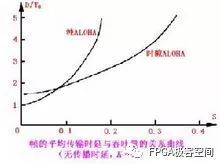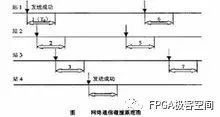basic introduction
In CSMA, due to the propagation delay of the channel, collisions still occur when two sites hear that there is no signal on the bus to send the frame. Since the CSMA algorithm does not have a collision detection function, even if a collision has occurred, the corrupted frame is still sent out, and the utilization of the bus is lowered. The improvement scheme is to enable the station to continue to monitor the media during the transmission time. Once the collision is detected, the transmission is stopped immediately, and a short blocking message (Jam) is sent to the bus to notify the stations on the bus that a collision has occurred, and the bus can be improved. Utilization.
Carrier Sense Multiple Access CSMA technology, also known as LBT (Listen Before Talk). The site to transmit data first listens to the presence or absence of carriers on the media to determine if there are other sites transmitting data. If the media is idle, the site can transmit data; otherwise, the site will evade for a while before trying. This requires a backoff algorithm to determine the time to avoid. The commonly used backoff algorithms are non-persistent, 1-persistence, and P-stick.
Non-persistent algorithm
The algorithm rules are: (1) If the media is idle, it can be sent immediately. (2) If the media is busy, wait for a random retransmission delay determined by the probability distribution and repeat the previous step. Using a random retransmission delay can reduce the likelihood of collisions. The disadvantage of the non-persistent algorithm is that even if there are several points of view that have data to send, but because everyone is delaying the waiting process, the media may still be idle, and the usage rate is reduced.
1-persistence algorithm
Algorithm rules: (1) If the media is idle, it can be sent immediately. (2) If the media is busy, continue listening until the media is detected to be idle and sent immediately. (3) If there is a conflict (a positive response is not received within a certain period of time), wait for a random amount of time and repeat steps (1) to (2).
The advantage of this algorithm is that as long as the media is idle, the site can be sent immediately, avoiding the loss of media utilization; the disadvantage is that if there are two or more sites with data to send, the conflict is inevitable.
P-stick algorithm
Algorithm rules: (1) Listening to the bus, if the media is idle, it is sent with a probability of P, and delayed by a probability of (1-P) by one time unit. A unit of time is usually equal to twice the maximum propagation delay. (2) After delaying one time unit, repeat step (1). (3) If the media is busy, continue listening until the media is idle and repeat step (1).
The P-persistence algorithm is a compromise that reduces conflicts like non-persistent algorithms and reduces media idle time like a 1-stick algorithm. The problem is how to choose the value of P, which should be taken into account to avoid the unstable state of the system under heavy load. If the media is busy, there are N stations that have data waiting to be sent. Once the current transmission is completed, the total expected number of stations to be transmitted is NP. If P is too large and NP>1, indicating that multiple sites are trying to send, the conflict is inevitable. In the worst case, the throughput is reduced to zero as the probability of collision increases. Therefore, you must choose the appropriate P value to make NP <1. Of course, if the P value is too small, the media utilization rate will be greatly reduced.

Average transmission delay of a frame versus throughput
Carrier Sense Multiple Access/Collision Detection (CSMA/CD): In CSMA, due to the propagation delay of the channel, collisions still occur when two stations hear that there is no signal on the bus and send the frame. Since the CSMA algorithm does not have a collision detection function, even if a collision has occurred, the corrupted frame is still sent out, and the utilization of the bus is lowered. An improved solution for CSMA is to enable the station to continue to monitor the media during transmission time.

Network communication schematic
Basic definition
When a conflict is detected, the transmission is stopped immediately, and a short blocking message (Jam) is sent to the bus to notify the station that the collision has occurred on the bus, so that the channel capacity is not wasted by transmitting the damaged frame in vain. To improve bus utilization, this is called Carrier Sense Multiple Access/Collision Detection Protocol, abbreviated as CSMA/CD. This protocol has been widely used in Ethernet and IEEE802.3 standards.
At this point, the wasted bandwidth is reduced to the time it takes to detect the collision. So, how do you estimate the required collision detection time? For a baseband bus, the time used to detect a collision is equal to twice the maximum propagation delay between any two stations, so for baseband CSMA/CD, The packet length is required to be at least twice the propagation delay, otherwise the transmission is completed before the collision is detected, but the packet is actually corrupted by the collision.
Development application
CSMA/CD uses a contention method to determine access to the medium. This contention protocol is generally used in bus networks. Carrier Sense Multiple Access (CSMA) development and problems:
A key technical problem in the CSMA/CD bus network is the conflict control or collision resolution problem, that is, the message that is collided due to the transmission conflict is retransmitted after a random delay, and the typical collision control algorithm, that is, the backoff algorithm has The following five types: binary exponential back-off algorithm BEB, polynomial fallback algorithm PB, linear value-added back-off algorithm LIB, fixed average back-off algorithm FMB, sequential back-off algorithm OB.
Conflict detection protocol
In CSMA, due to the existence of channel propagation delay, collisions may occur even when two stations on the bus do not listen to the carrier signal and transmit frames. Since the CSMA algorithm does not have a collision detection function, even if a collision has occurred, the corrupted frame is still transmitted, and the utilization of the bus is lowered.
An improved solution for CSMA is to continue to listen to the media during the transmission of the transmitting station to detect the presence of a collision. If a collision occurs, the amplitude of the carrier signal transmitted by the transmitting station itself can be detected on the channel, thereby determining the existence of the collision. Once the collision is detected, the transmission is stopped immediately, and a series of blocking signals are sent to the bus to notify other relevant stations on the bus. In this way, the channel capacity is not wasted by transmitting the damaged frames, which can improve the utilization of the bus. This scheme is called Carrier Sense Multiple Access/Collision Detection Protocol, abbreviated as CSMA/CD, which has been widely used in LANs.
The cost of CSMA/CD is the time it takes to detect collisions. For the baseband bus, the worst case time for detecting a collision is equal to twice the propagation delay between any two stations. Sending data from one site to another begins to receive data, that is, the time it takes for the carrier signal to travel from one end to the other, called the signal propagation delay. Signal propagation delay (μs) = distance between two stations (m) / signal propagation speed (200 m / μs). Assume that the two sites A and B are located at both ends of the bus, and the maximum propagation delay between the two sites is tp. When the A station sends data, after the maximum propagation delay tp is approached, the B station just sends the data, and the collision occurs. After the conflict occurs, the B site can detect the conflict immediately, and the A site needs to pass a maximum propagation delay tp before the collision can be detected. That is, in the worst case, for baseband CSMA/CD, the time to detect a collision is equal to twice the maximum propagation delay between any two stations (2tp).
The data frame is sent from one station to the time required for the data frame to be transmitted and the data transmission delay. Similarly, the data transmission delay also indicates that a receiving station starts receiving data frames until the data frame is received. time. Data transmission delay (s) = data frame length (bit) / data transmission rate (bps). If the delay introduced by the repeater is not considered, the total time required for the data frame to start from one station to be received by the other station is equal to the sum of the data transmission delay and the signal propagation delay.
It can be seen from the above analysis that in order to ensure that the transmitting data station can detect possible collisions during transmission, the transmission delay of the data frame is at least twice the propagation delay. In other words, the length of the packet is required to be no shorter than a certain value, otherwise the transmission has ended before the collision is detected, but in reality the packet has been corrupted by the collision.
Due to the one-way transmission, for the broadband bus, the collision detection time is equal to four times the maximum propagation delay between any two stations. and so,
For wideband CSMA/CD, the transmission delay of the data frame is required to be at least 4 times the propagation delay.
In the CSMA/CD algorithm, once the collision is detected and the blocking signal is sent, in order to reduce the probability of collision again, it is necessary to wait for a random time and then use the CSMA method to attempt transmission. In order to ensure that this back-off operation is stable, a rule called binary exponential backoff and algorithm is adopted. The rules are as follows: (1) For each data frame, when the first collision occurs, a parameter L=2 is set; (2) the backoff interval is taken. 1 to a random number of L time slices, 1 hour is equal to twice the maximum propagation delay between two stations; (3) When the data frame conflicts again, the parameter L is doubled; (4) Set a maximum retransmission The number of times, if it is exceeded, it will not be retransmitted and an error will be reported.
The binary exponential backoff algorithm is controlled in the order of LIFO (List In First Out), that is, data frames that do not have conflicts or rarely collide, have a probability of preferential transmission; and data frames that have multiple conflicts occur, There is less probability of success in sending.
IEEE 802.3 is a CSMA/CD media access control method using binary exponential backoff and 1-persistence algorithm. In this way, at low load, if the media is idle, the station that wants to send the data frame can send immediately; when the load is heavy, the stability of the system can still be guaranteed. Since the signal propagating on the media is attenuated, the CSMA/CD bus network limits the maximum length of a branchless cable to 500 meters to ensure that a collision signal can be detected.

Cast Iron LV 3PH Asynchronous Motor
Cast Iron Lv 3Ph Asynchronous Motor,Three Phase Asynchronous Cast Iron Motors,Cast Iron Motors,Cast Iron Electric Motor
Yizheng Beide Material Co., Ltd. , https://www.beidevendor.com